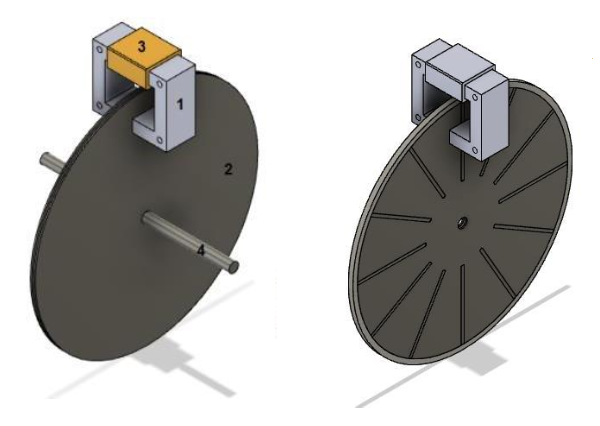Main Article Content
Abstract
The development of transportation technology in the automotive sector such as electric vehicles is increasingly advanced. One technology that is needed quite a lot is the development of supporting technology for electric vehicle braking. The use of regenerative braking on light electric vehicles such as 2-wheeled vehicles is not efficient because of its low weight. The use of Eddy Current Brake (ECB) can be a solution for braking support needs. This is because the ECB is a braking system that has the advantage of a lightweight design but still relies on the frictionless principle. However, in addition to its advantages, the eddy current brake is still in the early stages of its research with efficiency that still needs to be developed. In the discussion of the ECB, heat generation is one of the interesting topics to be discussed. Specifically, the study of the characteristics of the unipolar ECB axial performance on heat generation events has not yet been discussed. So this article aims to discuss these events with a simulation process and simple mathematical calculations. Design optimization is done to get the best value. As a result, the use of eddy current brakes with conductor disks using slots, can improve the performance of the ECB on the torque side and cooling side. Thus, this article is a good contribution to the sustainability of ECB research in both the general and automotive fields.
Keywords
Article Details

This work is licensed under a Creative Commons Attribution-NonCommercial 4.0 International License.
References
- R. Yazdanpanah and M. Mirsalim, “Hybrid electromagnetic brakes: design and performance evaluation,” IEEE Trans. Energy Convers., vol. 30, no. 1, pp. 60–69, 2014.
- I. H. Jee, S. Y. Nahm, S. J. Kang, and K. Ryu, “A magnetic brake for small wind turbines,” J. Magn., vol. 17, no. 1, pp. 33–35, 2012.
- S.-M. Jang, S.-S. Jeong, and S.-D. Cha, “The application of linear Halbach array to eddy current rail brake system,” IEEE Trans. Magn., vol. 37, no. 4, pp. 2627–2629, 2001.
- M. Gulec and M. Aydin, “Modelling and analysis of a new axial flux permanent magnet biased eddy current brake,” in 2016 XXII International Conference on Electrical Machines (ICEM), 2016, pp. 459–465.
- M. R. A. Putra and D. D. D. P. Tjahjana, “Fractures on braking component and relations to land-based transportation accident,” Procedia Struct. Integr., vol. 27, pp. 147–154, 2020.
- S. Deshpande, A. Kamat, R. Dalvi, and Y. Deshpande, “Review on Thermal Cracking Phenomenon in Brake Disc,” Int. J. Eng. Res. Technol., vol. 6, p. 6, 2017.
- M. R. A. Putra, M. Nizam, D. D. D. P. Tjahjana, M. Aziz, and A. R. Prabowo, “Application of multiple unipolar axial eddy current brakes for lightweight electric vehicle braking,” Appl. Sci., vol. 10, no. 13, p. 4659, 2020.
- N. Zou, Q. Wang, W. Wang, and X. Zeng, “Simulation study of CVT ratio control for engine braking,” in 2009 International Conference on Measuring Technology and Mechatronics Automation, 2009, vol. 2, pp. 367–370.
- G. L. Anantha Krishna and K. M. Sathish Kumar, “Investigation on Eddy Current Braking Systems–A Review,” Appl. Mech. Mater., vol. 592, pp. 1089–1093, 2014.
- A. K. Singh and A. K. Sharma, “Parameter identification of eddy current braking sytem for various applications,” in 2014 Innovative Applications of Computational Intelligence on Power, Energy and Controls with their impact on Humanity (CIPECH), 2014, pp. 191–195.
- H. T. Waloyo, U. Ubaidillah, D. Tjahjana, M. Nizam, and T. Koga, “Mini review on the design of axial type eddy current braking technology,” Int. J. Power Electron. Drive Syst., vol. 10, no. 4, p. 2198, 2019.
- M. Gulec, E. Yolacan, and M. Aydin, “Design, analysis and real time dynamic torque control of single‐rotor–single‐stator axial flux eddy current brake,” IET Electr. Power Appl., vol. 10, no. 9, pp. 869–876, 2016.
- T. Garbiec, M. Kowol, and J. Kołodziej, “Design considerations of high-speed eddy-current brake,” Arch. Electr. Eng., vol. 63, no. 2, pp. 295–304, 2014.
- R. Yazdanpanah and M. Mirsalim, “Analytical study of axial-flux hybrid excitation eddy current brakes,” Int. J. Appl. Electromagn. Mech., vol. 47, no. 4, pp. 885–896, 2015.
- A. Sinmaz, M. O. Gulbahce, and D. A. Kocabas, “Design and finite element analysis of a radial-flux salient-pole eddy current brake,” in 2015 9th International Conference on Electrical and Electronics Engineering (ELECO), 2015, pp. 590–594.
- S. Cho, H.-C. Liu, H. Ahn, J. Lee, and H.-W. Lee, “Eddy current brake with a two-layer structure: Calculation and characterization of braking performance,” IEEE Trans. Magn., vol. 53, no. 11, pp. 1–5, 2017.
- Y. Jin, B. Kou, L. Zhang, H. Zhang, and H. Zhang, “Magnetic and thermal analysis of a Halbach Permanent Magnet eddy current brake,” in 2016 19th International Conference on Electrical Machines and Systems (ICEMS), 2016, pp. 1–4.
- M.-G. Park, J.-Y. Choi, H.-J. Shin, and S.-M. Jang, “Torque analysis and measurements of a permanent magnet type Eddy current brake with a Halbach magnet array based on analytical magnetic field calculations,” J. Appl. Phys., vol. 115, no. 17, p. 17E707, 2014.
- S.-M. Jang, S.-H. Lee, and S.-S. Jeong, “Characteristic analysis of eddy-current brake system using the linear Halbach array,” IEEE Trans. Magn., vol. 38, no. 5, pp. 2994–2996, 2002.

